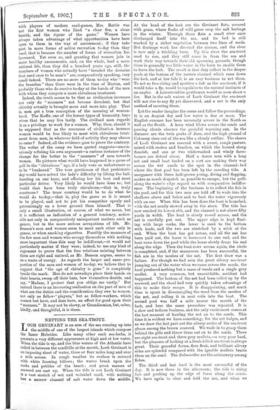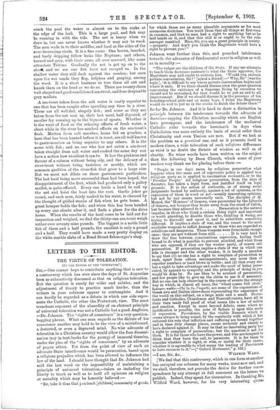NETTING THE SEA-TROUT.
LOCH GR1JINART is an arm of the sea running up into the middle of one of the largest islands which compose the Inner Hebrides. Like many other such Bea-lochs, it Presents a very different appearance at high and at low water. When the tide is up, and the blue waters of the Atlantic have rolled in between the sandhills at the mouth, Loch Gruinart is an imposing sheet of water, three or four miles long and over a mile across. In rough weather its surface is covered with white foaming billows; the waves break upon the rucks and pebbles of the beach ; and great masses of seaweed are cast up. When the tide is out Loch Gruinart is a vast stretch of wet and wrinkled sand, with nothing but a narrow channel of salt water down the middle.
At the head of the loch are the Gruinart flats, covered with grass, where flocks of wild geese crop the salt herbage in the winter. Through these flats a small river once discharged itself into the sea, and its bed is still marked by a richer vegetation between two lines of reeds. But drainage work has diverted the stream, and the river is now only a trickling burn. Up this river the sea-trout used to run, and they still come in from the sea and work their way towards their old spawning grounds, though there is generally too little water in the burn to enable them to leave the loch. The result is that they collect in the deeper pools at the bottom of the narrow channel which runs down the loch, and at low tide it is an easy business to net them. To net so free-rising and sportive a fish as the sea-trout, if it would take a fly, would be repulsive to the natural instincts of an angler. A Leicestershire gentleman would as soon shoot a fox. But in the salt waters of Loch Gruinart the sea-trout will not rise to any fly yet discovered, and a net is the only method of securing them.
Let the reader imagine the scene and follow the proceedings. It is an August day and low water is due at noon. The English summer has been unusually severe in the North as well as the South. A keen wind blows across the sands and passing clouds obscure the grateful warming sun. In the distance are the twin peaks of Jura, and the high ground of Colonsay rises out of the sea like a cloudy outline. The shores of Loch Gruinart are covered with a sweet, rough pasture, mixed with rushes and bracken, on which the horned sheep flourish, and one or two whitewashed and windy farm- houses are dotted about. Half a dozen men with a long net and small boat loaded on a cart are making their way across the wet sands to the spot in the channel-bed where the first pool has been left by the receding tide. A merganser with three half-grown young, diving and flapping, makes as much despatch as possible to escape; but the gulls along the water's edge regard us with comparative indiffer- ence. The beginning of the business is to collect the fish in the pool, and for this two men are told off to wade into the shallows above and below and to beat the water vigorously with an oar. When this has been done the boat is launched, with the net neatly stowed away in the stern. The tide has now reached its lowest ebb, and the channel is not above fifty yards in width. The boat is slowly rowed across, and the net is carefully put out. The upper edge is kept float- ing with large corks, the lower is sunk to the bottom with leads, and the two are stretched by a stick at the end. When the boat has got across, and all the net has been paid out, the horse is harnessed to one end, and the boat rows down the pool while the horse slowly drags his end along the edge. Then the boat rows across again, the circle is completed, and, if the manceuvre has been successful, the fish are in the meshes of the net. The first draw was a failure. For though we bad seen the great silvery sea-trout jumping out of the water when we came across the sands, the haul produced nothing but a mass of weeds and a single grey mullet. A very common, but unavoidable, accident bad happened. The bottom of the net had been rolled up by the seaweed, and the shoal had very quickly taken advantage of this to make their escape. It is disappointing, and much time is spent in disentangling the weed from the meshes of the net, and rolling it in neat coils into the boat. The second pool was half a mile nearer the mouth of the loch, and here the same procedure was repeated. It is a slow and tedious business, and the only excitement comes at the last moment of hauling the net on to the sands. This time it is evident we have something; for the net bulges, and as we draw the last part out the silvery scales of the sea-trout gleam among the brown seaweed. We wade in to grasp them behind the gills and throw them out on to the sands. There are eight sea-trout and three grey mullets,—a very poor haul, but the pleasure of looking at a fresh-killed sea-trout is always great. Their graceful forms, firm flesh, and brilliant silvery sides are splendid compared with the ignoble mullets beside them on the sand. The Salnwnidae are the aristocracy among fishes.
The third and last haul is the most successful of the day. It is now three in the afternoon ; the tide is rising fast and pushing up the edge of foam along the sands. We have again to clear and fold the net, and when we reach the pool the water is almost on to the rocks at the edge of the loch. This is a large pool, and fish may be running in with the tide. The net is heavy when we draw in, but one never knows whether it may not be weed. The men wade in to their middles, and haul at the sides of the ever-decreasing circle. It is a fine scene. One brown, bearded, and burly dripping fellow looks like Neptune ; and others, tanned and grey, with their arms all over seaweed, like some attendant Tritons. Gradually the net is got up on to the shorn, and we see our fish have not escaped us. In the shallow water they still dash against the meshes; but once upon tLe wet sands they flop, helpless and gasping, among the weed. It is a short business to toss them all out and knock them on the head as we do so. There are twenty-three well shaped and good-conditioned sea-trout, and four despicable grey mullets.
A sea-trout taken from the salt water is vastly superior to one that has been caught after spending any time in a river. These are all well-fed, shapely fish; and some as they are taken from the net cast up their last meal, half digested, of smaller fry running up to the bigness of sprats. Whether it is the want of food or the relaxing effects of fresh water, a short while in the river has marked effects on the sea-trout's flesh. Mutton from salt marshes, hams fed on peaches, a hare that has been hunted before it is roast, are all well known to gastronomists as being superior to any others. It is the same with fish ; and no one who has not eaten a sea-trout taken straight from salt water and cooked the same day can have a notion how excellent it can be. It has the pinkness and flavour of a salmon without being oily, and the delicacy of a river-trout without being tasteless or muddy, which are common qualities of the river-fish that grow to a large size. But we must not dilate on these gastronomic particulars. The last haul being more successful than had been hoped, the disappointment of the first, which had produced only a paltry mullet, is quite effaced. Every one lends a hand to coil up the net and hoist the boat into the cart. Gaelic jokes go round, and each man, fairly soaked to his waist, is cheered by the thought of grilled steaks of fish when he gets home. A great hamper bolds the fish ; and when this has been handed up every one climbs after it, and finds a place for the drive home. When the results of the haul come to be laid out for inspection and weighed, we find the thirty-one sea-trout weigh rather over seventy-nine pounds. The biggest is a noble little fish of three and a half pounds, the smallest is only a pound and a half. They would have made a very pretty display on the white marble slabs of a Bond Street fishmonger's shop.







































 Previous page
Previous page